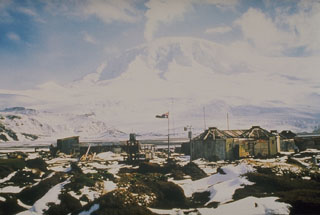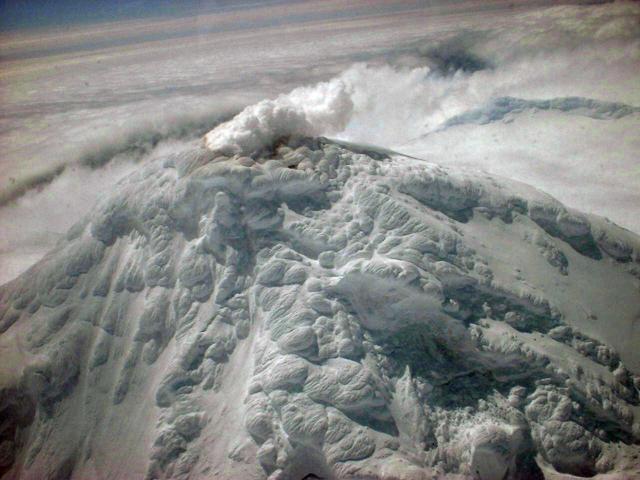Report on Heard (Australia) — November 2000
Bulletin of the Global Volcanism Network, vol. 25, no. 11 (November 2000)
Managing Editor: Richard Wunderman.
Heard (Australia) Discovery of a distinct vent below Mawson Peak; brown fumes in November
Please cite this report as:
Global Volcanism Program, 2000. Report on Heard (Australia) (Wunderman, R., ed.). Bulletin of the Global Volcanism Network, 25:11. Smithsonian Institution. https://doi.org/10.5479/si.GVP.BGVN200011-234010
Heard
Australia
53.106°S, 73.513°E; summit elev. 2745 m
All times are local (unless otherwise noted)
Activity from Mawson Peak, a discrete volcanic cone that lies atop Big Ben stratovolcano, was observed by the Australian National Antarctic Research Expedition (ANARE) during October-November 2000. Frequent cloud cover obscured Big Ben.
On 19 October, workers observed several hours of fumarolic activity from the RSV Aurora Australis while 2-3 km off the N shore of Heard Island between Corinthian and Spit Bays. Gaseous emissions were rising at least 200 m above the summit. During the early morning of 20 October, those aboard the ship observed similar continuing activity until clouds obscured the view. From the Red Island area at the W end of Heard Island, on 28 October strong fumarolic activity was seen emanating from the summit of Mawson Peak. Observers suggested the presence of a second emission point on the S slopes 100-200 m below the summit.
On 9 November, a helicopter flyover of Mawson Peak revealed that the crater and lava lake observed in 1987 were no longer visible. Instead, the summit had the form of a steep, irregular ice dome with gases venting through its apex (figure 4). The flyover also confirmed an apparently distinct area of activity 150-200 m below Mawson Peak near the head of Lied Glacier (Kiernan and McConnell, 2000). This newly discovered area was separated from the summit vent by several hundred meters of clean, white ice.
Reports of more than one red glow source from the 1950-52 and 1985 eruptive events hinted at the possible existence of a second vent on Big Ben (ANARE Station Reports, and Neumann van Padang, 1963). Recent failure to locate such a vent led Quilty and Wheller (2000) to conclude that the previously observed multiple red glows were attributable to magma ponded in the summit crater and lava flowing down Big Ben's flanks. Current observations, however, now suggest the presence of a separate, lower vent in the vicinity of the 1985 flow.
On 13 November observers from Fairchild Beach on the N coast of Heard Island noted brown fumes venting from the summit area. The following day, fumarolic activity was observed from a vantage point on the E moraine of Browns Glacier Lagoon on the N coast.
References. Kiernan, K., and McConnell, A., 2000, ASAC Project 1118, Geomorphological Evolution of Heard Island: Report to Atlas Cove Station Leader, ANARE.
Neumann van Padang, M., 1963, Arabia and the Indian Ocean: Catalogue of the Active Volcanoes of the World, v. 16, p. 1-64.
Quilty, P.G., and Wheller, G., 2000, Heard Island and the McDonald Islands: A window on the Kerguelen Plateau: Papers & Proceedings of the Royal Society of Tasmania, v. 133, no. 2, p. 1-12.
Geological Summary. Heard Island on the Kerguelen Plateau in the southern Indian Ocean consists primarily of the emergent portion of two volcanic structures. The large glacier-covered composite basaltic-to-trachytic cone of Big Ben comprises most of the island, and the smaller Mt. Dixon lies at the NW tip of the island across a narrow isthmus. Little is known about the structure of Big Ben because of its extensive ice cover. The active Mawson Peak forms the island's high point and lies within a 5-6 km wide caldera breached to the SW side of Big Ben. Small satellitic scoria cones are mostly located on the northern coast. Several subglacial eruptions have been reported at this isolated volcano, but observations are infrequent and additional activity may have occurred.
Information Contacts: Kevin Kiernan, Geography and Environmental Studies, University of Tasmania, GPO Box 252-79, Hobart TAS 7001, Australia.


